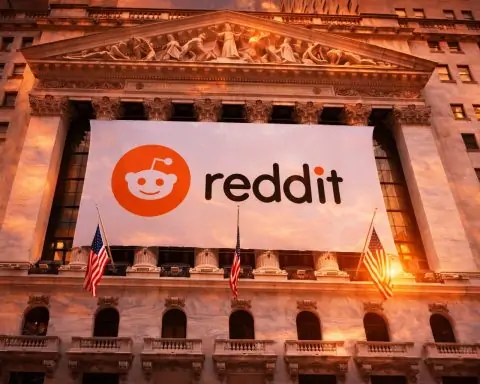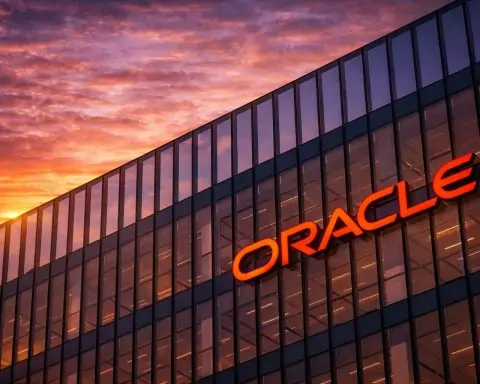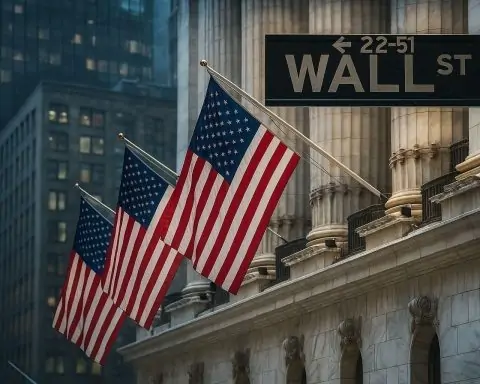Gold prices have soared this October, breaching $4,300/oz for the first time ever and up over 60% year-to-date [1] [2]. The safe-haven rally is driven by Fed rate-cut expectations, US political uncertainty and global tensions [3] [4]. Analysts note no clear end to the rally: Metals Focus’s Matthew Piggott targets ~$5,000/oz absent a “major shift” [5], and HSBC now sees gold averaging near $5,000 by 2026 [6] [7]. In Asia, Diwali/Dhanteras festival buying has pushed Indian premiums to decade highs [8], with domestic prices at ~₹1,31,700 per 10g [9]. Bullion flows are “insatiable” – record ETF inflows (~$64bn YTD) and heavy central bank buying underpin the surge [10] [11]. Even silver joined the run – hitting a record ~$54.47/oz in mid-October [12]. Meanwhile US stocks (Dow, S&P, Nasdaq) ticked up as gold paused [13], reflecting eased bank-credit worries and trade jitters.
Gold’s Record Surge and Drivers
In mid-October 2025 gold went parabolic. Spot gold briefly spiked above $4,378/oz (Oct 16–17), before a modest pullback on Friday [14]. It “breached $4,300/oz for the first time” amid a 7.6% weekly gain (as of Oct 17) [15]. This capped an astonishing run: gold is up roughly 64% this year, far outstripping last year’s 27% gain [16] [17]. TechStock² analysis notes 2025 has become “the strongest year for gold since the late 1970s,” making it one of the best-performing assets globally [18].
Why the surge? Markets are pricing in aggressive US Fed easing: a 25-basis-point rate cut in October is all but certain, and another likely in December [19] [20]. A looser Fed (and thus lower real yields) boosts gold’s appeal as a non-yielding safe-haven. “Mounting concerns around the Fed’s independence, political uncertainty, trade tariffs, geopolitical tensions and ballooning debts will continue to keep strategic interest strong for gold,” notes ANZ bank [21]. Indeed, safe-haven demand is surging amid global uncertainties: US debt deficits, ongoing Ukraine war and China’s slowing economy all add fuel. Even a brief Israel–Hamas ceasefire on Oct 9 only paused the rally momentarily. Conversely, Fed-minute caution on stubborn inflation has primed markets for cuts [22], and traders now talk of a “Goldilocks backdrop” of lower rates plus moderate inflation [23]. Meanwhile, China’s central bank and other reserves managers remain net buyers, continuing years of dollar-diversification [24] [25].
Political news also swayed bullion. Early on Oct 17, US President Trump indicated his planned 100% tariffs on China were “not sustainable,” and he confirmed a meeting with President Xi [26]. That calmer stance temporarily eased the rally – prompting a ~2–3% slide on Friday [27]. “I think Trump’s more conciliatory tone…has taken a little heat out of the precious metals trade,” said independent metals trader Tai Wong [28]. Even so, gold’s pullback was mild; it remains up strongly on the week. The US dollar index (DXY) firmed slightly, but longer-term weakness in the dollar and US bond yields has been a tailwind for gold [29].
India’s Dhanteras/Diwali Gold Bonanza
In Asia, the gold frenzy is most visible in India. With the Dhanteras-Diwali festival season in full swing, Indian consumers and investors are snapping up gold despite record prices. Domestic gold hit a record ₹131,699 per 10 grams in mid-October [30], and dealers quoted premiums of up to $25/oz – the highest in over a decade – above global benchmarks [31]. “The ongoing price rally is boosting investor interest in gold, even as jewellery demand remains weak,” reports Ashok Jain, proprietor of a Mumbai wholesaler [32]. Jewellers are stocking small coins and bars ahead of the festivals. Economic Times notes that although high prices may cut volumes by ~15–20%, total value of gold sales is still rising ~25% due to big 24K and coin purchases [33].
Gold smugglers are also active: Reuters reports surging smuggling into India amid shortages and record rates [34]. But the net effect is unprecedented buying pressure. “Indian buyers stocked up ahead of Dussehra and Diwali, paying record premiums,” notes a TS2.tech summary [35]. In China – the world’s other major consumer – demand has revived after summer holidays, with spot prices and imports picking up [36]. Hugo Pascal of InProved notes “global enthusiasm for precious metals persists, and Chinese demand seems to have returned as well” [37]. In Hong Kong/Singapore, inventory is reportedly very tight as traders sell at small discounts to keep the market supplied [38]. In Japan, buyers similarly shrugged off high prices: a Tokyo trader reports investors “don’t seem deterred by high prices, they’re just buying” [39].
Silver is also surging on this global demand. Silver hit a fresh 14-year high of ~$54.47/oz on Oct 16 [40] (a record), before a slight pullback. Industrial demand (from solar panels, EVs, electronics) remains robust, and silver-backed ETFs have seen strong inflows. Copper, platinum and palladium have also climbed on fears of inflation and supply risks, though well below their 2022 highs.
Bullion Flows and Forecasts
Investors and institutions are piling into gold. Central banks from China to Turkey have bought gold this year to diversify reserves [41] [42]. Gold-backed ETFs saw record inflows (~$64 billion YTD, including ~$17.3B in September alone) [43], reflecting what analysts call an “insatiable” demand for the metal. World Gold Council data confirm that flows into physical gold funds are at historic peaks, as both retail and institutional players view gold as a vital portfolio hedge [44] [45].
What next? Analysts remain overwhelmingly bullish in the near term. ANZ Research sees gold climbing to $4,400/oz by year-end and peaking near $4,600 by mid-2026, before easing once the Fed’s easing cycle concludes [46]. Standard Chartered’s Suki Cooper similarly forecasts gold averaging $4,488 in 2026 (up from ~$4,223 today) and notes “further upside risk from broader structural factors” [47]. HSBC has raised its forecasts too: now $3,350 for 2025 (vs $3,215 before) and about $3,950 for 2026 [48] – albeit well below current levels, implying they see some eventual pullback. However, even HSBC concedes it now expects gold to hit $5,000/oz next year [49].
Metals consultancy Metals Focus projects even higher long-term targets. MD Matthew Piggott stresses that the “extremely positive macroeconomic and geopolitical background” suggests “no obvious trigger to end the rally” right now; he targets around $5,000/oz in the coming years [50]. HSBC analysts also note that official-sector buying and policy uncertainty could push gold well above $4,000 [51] (the metal is already there). Capital Economics warns of a short-term “pullback” after this extreme run, but expects only modest dips before resumption of the uptrend [52].
Importantly, many experts see the current bull market as structural, not just a short-term spike. Economic Times quotes Darshan Desi of Aspect Bullion: “concerns about a potential US credit crisis, a weak dollar, and expected Fed rate cuts are supporting the rally” [53]. Similarly, the UK’s World Gold Council (WGC) notes that central bank buying and ETF inflows are at multi-year highs, and even average investors are buying gold in record volumes (for example, India’s coin and small-jewelry sales surged on Dhanteras) [54]. In short, there is “no catalyst…to retrace at present,” says Metals Focus – meaning gold could stay elevated until something fundamental changes [55].
Outlook and Market Impact
Looking ahead, gold’s path will hinge on a few key factors. Federal Reserve policy is top of mind: a surprisingly hawkish Fed or delay in promised cuts could slow the rally. For now, markets price in a 25bp cut this week (Oct 2025) and another in December [56] [57], which should support gold. Second, inflation and growth data will be watched closely. Cooling inflation might eventually reduce demand for hedges, but right now persistent inflation supports the story for gold as a store of value.
Trade and geopolitical news also loom large. Any re-escalation of US–China tensions (or new tariffs) could send gold even higher, whereas breakthroughs might temper safe-haven flows. Coming events include the Oct 31–Nov 1 Asia trade talks and any announcements around the US debt ceiling or European stability. In the US, comments by the President or Fed officials (e.g. Powell’s speeches) will likely move the market.
Seasonal demand in Asia adds another variable. Diwali/Dhanteras runs through Oct 20; after that, China’s Golden Week is over, but now India’s wedding season is about to begin. Historically, this time of year sees heavy jewelry and gift buying, which can sustain high local prices and premiums [58] [59]. Indeed, analysts note that Indian household gold purchases (including small-karat and lightweight jewelry) could keep a floor under prices in the weeks ahead.
On the other hand, if the Fed disappoints (cutting less than expected) or if the US dollar rallies strongly, we could see some profit-taking. Last week’s dip on Trump’s news shows even gold isn’t immune to market swings. But for now, “with the mix of Fed easing bets, weak real yields, and political uncertainty,” many believe gold has “no catalyst” to fall [60].
In summary, gold’s explosive rally in October 2025 reflects a rare alignment of low rates, high uncertainty and strong demand. Experts quoted here – from international banks to independent analysts – overwhelmingly predict that gold could stay on this trajectory, possibly reaching $5,000/oz or beyond before it levels off [61] [62]. As one trader put it, “Investors don’t seem deterred by high prices – they’re just buying,” whether in New York or Mumbai [63]. Whether you see it as a bubble or a structural bull market, gold is dominating headlines and portfolios – and the fireworks might continue through year-end and into 2026.
Sources: Reuters, Economic Times, TechStock² (ts2.tech) and Bloomberg reports [64] [65] [66] [67] [68] among others, which detail the recent price action, expert comments and forecasts on global gold markets. (See citations.)
References
1. www.reuters.com, 2. www.reuters.com, 3. economictimes.indiatimes.com, 4. www.reuters.com, 5. ts2.tech, 6. www.reuters.com, 7. www.reuters.com, 8. www.reuters.com, 9. www.reuters.com, 10. ts2.tech, 11. www.reuters.com, 12. www.reuters.com, 13. www.reuters.com, 14. www.reuters.com, 15. www.reuters.com, 16. www.reuters.com, 17. www.reuters.com, 18. ts2.tech, 19. economictimes.indiatimes.com, 20. www.reuters.com, 21. economictimes.indiatimes.com, 22. ts2.tech, 23. ts2.tech, 24. ts2.tech, 25. www.reuters.com, 26. www.reuters.com, 27. www.reuters.com, 28. www.reuters.com, 29. ts2.tech, 30. www.reuters.com, 31. www.reuters.com, 32. www.reuters.com, 33. economictimes.indiatimes.com, 34. www.reuters.com, 35. ts2.tech, 36. www.reuters.com, 37. www.reuters.com, 38. www.reuters.com, 39. www.reuters.com, 40. www.reuters.com, 41. ts2.tech, 42. www.reuters.com, 43. ts2.tech, 44. ts2.tech, 45. www.reuters.com, 46. economictimes.indiatimes.com, 47. www.reuters.com, 48. www.reuters.com, 49. www.reuters.com, 50. ts2.tech, 51. ts2.tech, 52. ts2.tech, 53. economictimes.indiatimes.com, 54. ts2.tech, 55. ts2.tech, 56. economictimes.indiatimes.com, 57. www.reuters.com, 58. ts2.tech, 59. ts2.tech, 60. ts2.tech, 61. www.reuters.com, 62. ts2.tech, 63. www.reuters.com, 64. www.reuters.com, 65. www.reuters.com, 66. ts2.tech, 67. www.reuters.com, 68. www.reuters.com









